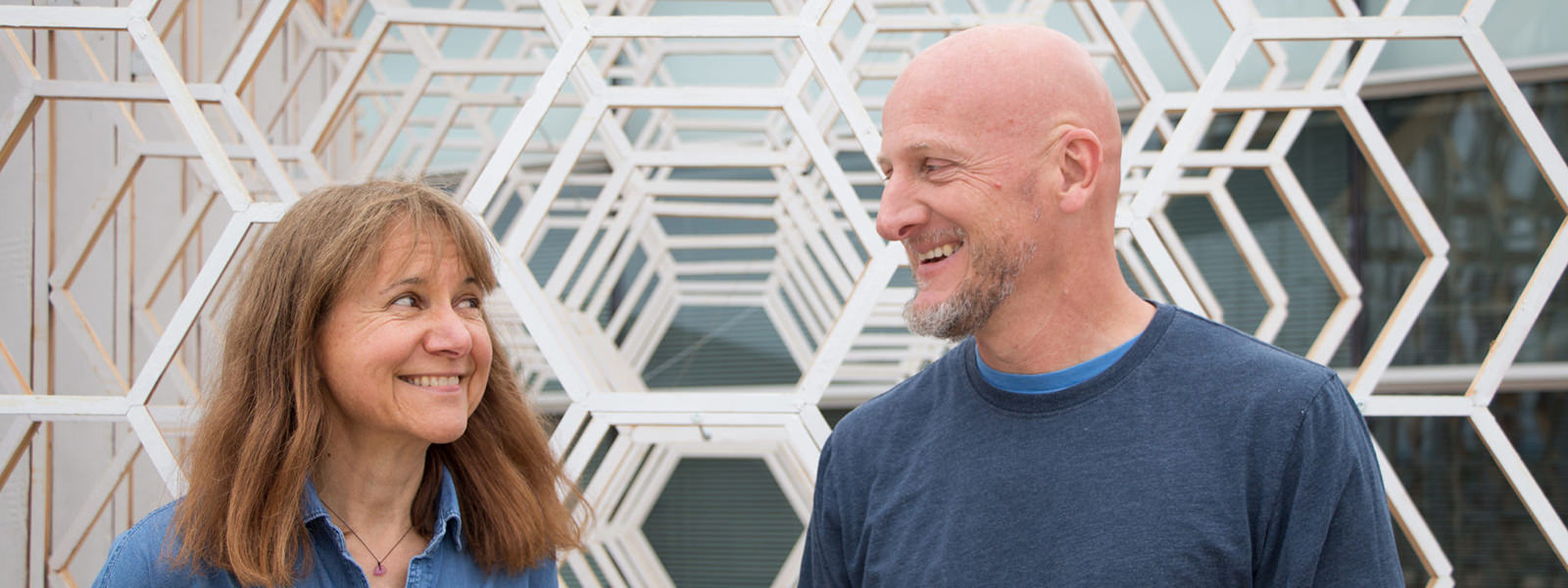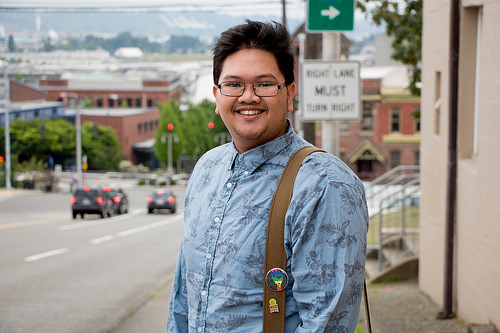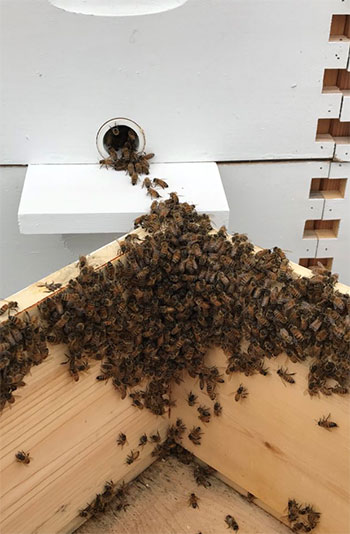
Generating Buzz
Foraging the Hive, a new art installation by Senior Lecturer Tyler Budge and his artistic partner Sara Young combines bees, test tubes and discarded items.
What do you make?
That’s the question being posed by a collaboration between UW Tacoma Senior Lecturer Tyler Budge and his artistic partner Sara Young in their Museum of Glass installation, “Foraging the Hive”.
Their installation opened May 26, but this isn’t the first time they’ve shared this sort of bricolage with the public. Budge and Young also exhibited similar work in Providence, in a site-specific installation called “Praesepe.”
The exhibition is multifaceted. It consists of three components: the interior, a swarm-like accumulation of glass test-tubes filled with mixed-media material; the exterior, a structure that will be home to four colonies of honey bees; and a chance for the community to become a part of the exhibition.

Budge and Young worked together on this particular exhibition for five years, but their partnership began earlier than that. They met as graduate students at Illinois State University and have collaborated since 2001. Their work on this particular installation has developed on both coasts, with Young creating in Providence, Rhode Island and Budge in Tacoma.
Inspiration for “Foraging the Hive” came from a place where ideas are often had: at a dinner table. Budge and Young were at the tail end of their graduate education and brainstorming ways to work together once they’d finished. After eating at a Chinese restaurant, they were cracking open their fortune cookies when an idea emerged from the small papers within. One read, "You will have a long and healthy life," and the other, "Reasonable people endure; passionate people live." "We decided based on receiving these little thin pieces of paper that we would start making little collages that would fit into glass test tubes in our own studios every day," Young said. Those fortunes became the first test tubes of Budge and Young’s installation.
Budge and Young also took inspiration from their own experience with beekeeping. For Young, it was wanting to understand the origins of the beeswax she used when blowing glass. In Budge’s case, memories of his grandfather’s bee farm helped inform his vision for the piece. "When we'd go to visit him, we would visit the honey house,” Budge said. “It was frightening because there were hundreds of thousands of bees everywhere, but it was an amazing place."
The interior portion of “Foraging the Hive” is comprised of approximately 8,000 test tubes. In each test tube are manipulated objects Budge and Young found over the course of 10 years and carefully repurposed to create what Young calls, “a new narrative.” One example of this is an acrylic false fingernail Young found on a walk, which she combined with a plastic horse hoof. "Part of the allure in finding this stuff is reclaiming cast-off materials and reinventing them” into that new narrative, Young said.
But the installation is more than just re-purposing detritus. "It's observing the natural world and finding those parallels between what's taking place with the bees and our own creative practice,” Budge said. "When you think of a hive, it's a super organism; they're all working together to create a singular thing. Humans are the same way."
While the test tubes represent human creation, the exterior component will be active with the buzz of about 200,000 bees producing on their own. Before placing the bees in the house created for the installation, Budge kept them in his backyard. He projects the number will increase to around 400,000 by the end of the summer.
The third piece of the installation gives museum visitors the chance not only to be a part of the metaphorical swarm Budge and Young created, but to act as creators themselves. A separate room will provide museum visitors with discarded objects and test tubes laid across hexagonal tables. Signs on the walls will prompt them to manipulate the objects into a creation of their own that will be hung in the exhibit. "We're kind of deconstructing the artist as this queen bee who is the maker,” Budge said. “We're all the maker. We're all the worker bees. We're giving all the visitors the opportunity to be the maker of the show."
Students in Budge’s “Art and the Public” (TARTS 407) and “3-D Art” (TARTS 280) courses got the opportunity to help with installation and learned first-hand what goes into bringing a museum exhibition to life. Budge also had an intern, UW Tacoma senior Karl Tolentino.
Tolentino is majoring in arts, media and culture with an emphasis on visual arts and minoring in museum studies. He’s a first-generation student. Knowing Tolentino needed an internship for his minor, Budge approached Tolentino with the opportunity to work on the installation.

Tolentino was tasked with assisting in the building of the exterior structure. "My job was pretty much helping build the apiary that will be filled with bees," he said. But working with Budge gave Tolentino more than just insight into how an exhibition is formed; it helped him realize his own love of sculpture. “I knew I was creative but I didn’t know what I wanted to do,” Tolentino said. “Channeling that into a sculpture or installation is really amazing and the kind of art I want to do in the future.” Tolentino’s internship with Budge also led him to getting an internship at the glass museum.
Using bees as its context, Budge and Young’s project takes away the conventional idea of a single or few artists by placing emphasis on interdependency. “I hope people see that they are the creator—that their creative voices are as strong as ours and every bit as valuable," Budge said. Young agreed. "Hopefully we are supplying them with the materials to start that journey," she said.
Downtown Bees

Does the idea of 400,000 bees in downtown Tacoma set you on edge? Not to worry.
Bees are an integral part of the ecosystem, even in urban areas. In fact, urban areas provide a great variety of food. The bees will range up to three to five miles from the hive for pollen sources.
The hive location on the roof of the Museum of Glass was selected taking into consideration sun and wind exposure, and access to water and food sources. A pollinator garden has been installed, with plants selected specifically for the bees.
The artists and the Pierce County Beekeepers Association will be doing bi-weekly inspections of the hive to ensure the bee colony is healthy.
